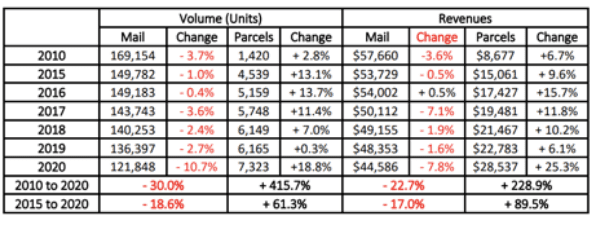
Three Takeaways from Latest Report on Postal Problems
Ross Marchand
October 20, 2021
From surging red ink to service standard slowdowns to transparency and privacy problems, the United States Postal Service (USPS) has been experiencing no shortage of issues. It’s difficult to put a finger on what exactly has gone wrong at America’s mail carrier, and outside analyses have been few and far between. Fortunately, longtime policy scholars Dr. Robert J. Shapiro and Isaac Yoder recently released a thorough analysis of the USPS’ ills. While it’s difficult to summarize the agency’s issues even in 45 pages, Shapiro and Yoder demonstrate that stagnant productivity, underpriced package deliveries, and a lack of transparency about cost attribution are creating a perfect storm of postal problems. Below are just a few takeaways from their important study:
The USPS is carrying out its core mission less effectively than ever before.
In order to keep goods and services moving on time, it’s critical for any logistics operation (whether public or private) to be as productive as possible. And yet, the USPS is failing to perform its duties as effectively as its private sector counterparts. Shapiro and Yoder note, “From 1987 to 2018, USPS unit labor costs grew 2.9% per-year with productivity gains averaging 0.4% per-year. Over the same years, the unit labor costs of the subindustries comprising the transport, shipping, delivery, and warehouse industry grew an average of 0.4% per-year with productivity gains averaging 2.4% per-year.”
Of course, it’s easier for a company or organization to be productive when there’s a well-defined mission and employees have a clearly defined scope of responsibility. That is becoming more difficult at the USPS as the agency delivers less traditional mail in favor of heavy parcels:

Source: Sonecon.
The substitution of letter mail for parcels is a major factor behind mail slowdowns.
While pandemic-era mail slowdowns attracted plenty of media attention and Congressional scrutiny, the USPS’ performance for first-class mail was already declining in the years preceding the pandemic. According to Shapiro and Yoder, “USPS data also provide the average delivery time for all First-Class Mail, local and non-local and on time and not, from 1990 to 2020. For the first 15 years of that period, the burden of the growing volume of First-Class Mail led to longer average delivery times: From 1990 to 2005, the average delivery time increased from 1.6 days to 1.85 days as the annual volume of First-Class Mail grew from 85 billion pieces to nearly 100 billion pieces. However, as the volume of First-Class declined by nearly 50 percent from 2005 to 2020, the average delivery time more than doubled to 2.5 days.”
To try and isolate the cause of these longstanding slowdowns, the two scholars conducted a regression analysis and examined the relationship between inflation-adjusted delivery costs, revenue-weighted parcel volumes, and first-class local and non-local mail delivery times across 73 postal districts. Shapiro and Yoder break down the regression analysis into two time periods, one completely pre-pandemic (FY 2014 to FY 2020) and another that includes data through December 2020. Based on the statistical significance of the results, they find that for both time periods, “when the growth of USPS’s inflation-adjusted operating costs increased and when USPS parcel volumes increased, on-time delivery of First-Class mail deteriorated.”
These findings make sense given USPS workers’ struggles in efficiently hauling in packages for processing and out for delivery. And, of course, this issue intensified during the early stages of the pandemic as Americans opted to stay home and order their items online instead of venturing out into stores. This ramping up of parcel deliveries needn’t be a problem if the USPS can charge sufficient postage on these items and use the revenues to adequately invest in infrastructure.
The USPS isn’t opening up about how they price their products.
As a federal agency, it would be a reasonable expectation that the USPS publishes its cost assumptions used for determining how it prices products. Some, not all, of this analysis is public. It’s up to the Postal Regulatory Commission (PRC) to define a minimum “appropriate share” of agency resources to be attributed to package deliveries for cost calculations, and the PRC does share with the public this “appropriate share” figure (currently 8.8 percent). The idea is that, if the agency underestimates the share of agency resources going toward parcel deliveries, these deliveries will appear to be cheaper on paper than in reality and prices will be set below actual delivery costs.
The problem, though, is that the USPS may be incorrectly estimating the amount of resources that are going toward package deliveries. Shapiro and Yoder note, “The PRC and USPS do not permit any outside agency or private researchers to examine USPS’s detailed cost accounting and thereby verify the minimum…8.8 percent appropriate-share calculations.” And based on the clues there are on the assumptions the USPS makes, it appears likely that the agency is understating delivery costs. This can result in the underpricing of packages at a time when the USPS is bleeding red ink.
To conclude…
There’s nothing inherently wrong with the USPS delivering a significant number of packages. But the agency needs to be upfront about its cost assumptions and the tradeoff between letter delivery times and package volumes. That tradeoff can be kept to a minimum but only if products are priced correctly and outside analysts can check the agency’s math.
